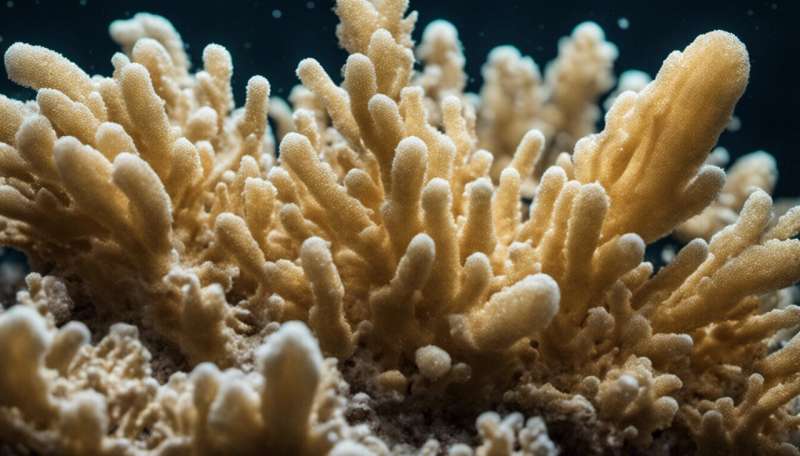Credit: AI-generated image (disclaimer)
CO2 emissions don't just affect our atmosphere. According to some estimates, over a third of CO2—one of the primary greenhouse gases—is absorbed by the oceans. The second-most abundant element in the Earth's crust after oxygen, and part of sediments, minerals and rocks in the oceans, silicon is also found in dissolved form in seawater. Silica forms the skeleton structures of a variety of aquatic plankton, including many diatoms, photosynthetic algae found in marine and freshwater ecosystems. Dissolved silicon is necessary for the growth of many species of diatoms, which are among the key organisms involved in removing CO2 from the Earth's atmosphere.
Partially supported by the EU-funded SponGES project, a team of scientists has shown that most of the silicon in the oceans comes from sea sponges, and not just from diatoms as previously thought. The findings were published in the journal Nature Geoscience.
During photosynthesis, diatoms turn CO2 into organic carbon and generate oxygen in the process. When they die, diatoms typically sink to the seafloor, taking carbon out of the surface waters and locking it into sediments below. The sinking of carbon and silica out of the surface ocean helps keep this atmospheric greenhouse gas in check. The dissolved silica is recycled and eventually upwelled for use again in the sunlit (euphotic) zone. How fast this cycle turns and how much silica is supplied for diatom growth will have implications for warming or cooling our climate. "As glaciers and polar caps continue to thaw, it is necessary to find out whether other important biological sinks of dissolved silicon occur in the ocean, in addition to the burying of diatom skeletons," as reported in a press release on the project website. "More specifically, it was discovered that sponges are responsible for burying approximately 48 million tons of silicon every year through the microscopic pieces that make their siliceous skeletons. This finding increases about 28% the size of the biological silicon sink in the ocean, which had previously been calculated considering only the skeletons of diatoms."
Dark silica
In addition, the scientists have pointed to the notion of dark silica. This refers to "siliceous skeletons produced in disconnection from the photosynthesis and the consumption of CO2, often in marine environments lacking sunlight where diatoms cannot even survive," as explained in the press release. "Therefore, the quantification of the dark silica provided in this study does not only support that the silicon inputs and outputs of the marine silicon cycle are in equilibrium, but it also introduces the idea for further investigations that the functional connections between the carbon and silicon cycles in the ocean are not as straightforward as previously thought."
The ongoing SponGES (Deep-sea Sponge Grounds Ecosystems of the North Atlantic: an integrated approach towards their preservation and sustainable exploitation) project that contributed to the study "will improve predictive capacities by quantifying threats related to fishing, climate change, and local disturbances," as noted on CORDIS. Project partners also hope to "further unlock the potential of sponge grounds for innovative blue biotechnology namely towards drug discovery and tissue engineering."
More information: SponGES project website: www.deepseasponges.org/ Manuel Maldonado et al. Sponge skeletons as an important sink of silicon in the global oceans, Nature Geoscience (2019). DOI: 10.1038/s41561-019-0430-7
Journal information: Nature Geoscience
Provided by CORDIS
























